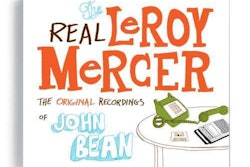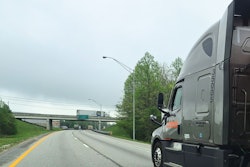The days of the prototypical heavy-duty truck with a long, straight hood and a wheelbase that reaches halfway across Texas are disappearing. Also vanishing for most truckers are overnight idling and insistence on maximum horsepower.
Yet, spec’ing your truck to improve aerodynamics, reduce wind drag and enhance fuel economy in a more highly regulated environment need not be solely an exercise in shaving pennies per mile. Chances are you’ll see the road better, feel less fatigued because of a smoother ride and less noise, shift less than you ever imagined you could because of better torque, and spend less time under the truck maintaining it.
Unless you spend most of your time well below highway speeds, your fuel bill is probably half spent pushing air. Today’s rigs are aerodynamically optimized by not only making air flow smoothly around the front of the tractor but by attempting to make the tractor and trailer function as an aerodynamic unit.
Freightliner’s Keith Harrington notes the fuel savings of aerodynamic design. “When basic aero cabs are equipped with roof fairings, cab side extenders and chassis side fairings, you have optimized the aerodynamics of the vehicle,” he says. “Each of these devices adds about 1 percent in fuel savings.”

Jerry Warmkessel, Mack’s marketing manager for highway products, advocates a fresh look at wheelbases to use the tractor aerodynamics to reduce trailer drag. “Keep the tractor-trailer gap close,” he says. “Too much gap will cost you more in fuel. To do this, you’ll have to remember that long-wheelbase tractors always tend to increase the tractor-trailer gap.” He suggests a 112-in. to 116-in. BBC (bumper to back of cab) dimension rather than 120-in. He says you’ll also need to order a sliding fifth wheel to optimize the gap.
Mike Morino, an International truck sales engineer, says you might want to save weight and cost by choosing a short wheelbase and then reducing the length of the slider appropriately. If you do, you won’t be sacrificing ride quality, he says.
“In current products, the idea that a longer wheelbase gives a better ride is not true, it’s a myth. There have been so many advances in ride technology, you don’t need to spec’ a long wheelbase. It’s only for appearance, and it’s costing you a lot of money,” he says.
Be careful how far you trim the cab vertically. Steve Crear of Schneider National Finance recommends not going below a cab height of 70 inches. “A sleeper that’s desirable will impact price in a positive way on the back end,” he says. “A lower height ends up going for a discount at sale time. A 72-in. or 75-in. standup sleeper is worth even more.”
Frank Bio, Volvo’s truck product manager, says Volvo’s cab side extenders can also close the cab-to-trailer gap. “There’s a trim tab on the roof fairing that matches the aerodynamics to the trailer gap,” he says. “It adjusts as necessary. The buyer runs the trim tab in different positions, depending on the tractor-to-trailer gap, and it can give about a 1 percent fuel savings. It costs about $275 and can pay for itself in two tankfuls of fuel.”
He adds that side fairings help with crosswinds. Without them, the wind blows under the truck at an angle from the front that tends to slow it down.
Truck profiles clearly matter these days. Crear says, “The square-nosed conventional is out of style, and we’ve been recommending the aero models to our owner-operators for at least the last three years. All the truck manufacturers offer competitive, aerodynamic trucks. I recommend you specify side and roof fairings – anything that will maximize slipperiness.”
Debbie Shust, International product planning and strategy manager, says, “Air fairings pay for themselves in a matter of months. You should specify these – side extenders and skirts. On Internationals, the aero treatments include an aerodynamic bumper design, fenders and a front axle fender that runs around the wheels.”
Andy Zehnder, Kenworth’s on-highway manager, says, “Side extenders deflect the air around the gap between the tractor and trailer to cause it to reattach quickly to the outside edge of the trailer.” Fairings alone, he says, decrease wind resistance 2 percent to 4 percent, resulting in 1 percent to 2 percent fuel savings.
Mack’s Warmkessel says side shields and side shield extenders help close the tractor-trailer gap. “Chassis fairings, including fuel tank fairings, aerodynamic bumpers and aero mirrors, are part of the U.S. Environmental Protection Agency SmartWay package option offered on Macks,” he says.
Zehnder advises to avoid external air cleaners. Unless you drive only in a quarry or at low speeds on secondary roads, they increase wind resistance far too much.
Ken Marko, Peterbilt’s market planning manager, says his company has several new aerodynamic products on both aerodynamic models and traditional models. “They give 24 percent less drag and up to a 12 percent fuel economy improvement when tested at 65 mph,” he says.
The packages include a roof fairing and trim tabs to route air up and over the trailer, a sleeper extension to route air around the sides of the trailer, aerodynamic mirrors, an aero bumper and even an aerodynamic battery box. He reports Peterbilt learned a lot from its Model 372, an aero cabover introduced in the late 1980s, about how to control airflow.
Volvo’s Bio suggests spec’ing a premium interior, but avoid an unusual color to ensure you don’t alienate buyers when it’s time to sell. Crear lists premium seats and a full gauge package as desirable options at resale.
Another option to spec is 22.5-in. diameter, fuel-efficient, low-profile tires that are SmartWay-certified to reduce rolling resistance. Wide singles should also be considered.
George Meiners, of Schneider National, says the best value for owner-operators comes with mid-range engines and drivetrains. He says, “Don’t spec’ extreme horsepower; 450-475 is more desirable than 550s. Heavy-duty transmissions and axles add both cost and weight.” Warranties are much cheaper on midrange components that are made in much greater numbers and have to transmit less torque.
Mack’s Warmkessel says, “You don’t need 600 horsepower to haul 80,000 pounds.” He thinks 425 hp is enough. Bio also believes an engine like Volvo’s D13, at 485 hp and 1,650 lb.-ft. of torque, is right for most operators needing good muscle under the hood.
Proper gearing for fuel economy is essential. “The engine of today likes to run in the 1,300-1,400 rpm band,” Freightliner’s Harrington says. “It is no longer wise to say, ‘I only run 3.55:1 gearsets.’ ” Experts tout the high value of choosing the tire diameter, axle ratio and transmission top gear ratio, so the engine will cruise in the “sweet spot” at your highway speeds. And multi-torque arrangements, along with digital in-dash fuel economy calculators, are highly recommended when you have a hired driver or two. Multi-torque engines add beef to the torque and power curves in top gear only, killing the incentive to downshift too early because doing so won’t reward the driver with more power.
Kenworth’s Zehnder says a GPS system can reduce out-of-route miles by about 3 percent a year.
Lightweight components, such as aluminum wheels, will also help save fuel and increase payload. When it comes to more exotic options like aluminum air tanks, however, Crear says, “You’d need an engineer to make the decision.” International’s Shust says, “You’ll get savings that pay back your cost with lightweight components, if you can add payload. Weight savings for fuel economy alone may or may not work.”
Marko advises looking at an all-aluminum cab and aluminum in the chassis, such as in spring brackets on Peterbilts.
Size makes a difference. “Select component sizes for the job,” Zehnder says. “If you don’t need heavy-duty components, don’t spec’ them. You’re paying for them every time you fill up.”
Harrington proposes a possible exception, oversize brakes. “One area to improve the performance of your vehicle is to consider a larger steer axle brake (16 by 5) and larger rear brakes (16.5 by 8.62). The advantage is more brake surface that actually increases the distance between relines.”
Larger brakes run cooler and increase wear miles significantly. If these brakes allow you to trade your vehicle without a reline, this option could pay. Front disc brakes offer extremely long maintenance intervals. Having stability control makes sense, too.
Bud Radowick, manager of fleet performance at Thermo King, says many fleets using the Thermo King diesel-powered auxiliary power unit have safely lengthened their oil change intervals by 10,000 miles because truck engine idling drops below 5 percent. He adds that the elimination of up to 30,000 hours of idle time, which a buyer can see via the engine control module, enhances resale value.
Truck manufacturers recommend an APU as a means to reduce operating costs and enhance resale value. Volvo supplies one designed to be easily removed and installed on your next vehicle, Bio says.
Harrington says, “The new path is toward electrically driven HVAC systems that operate off of a second set of batteries. These provide eight to 10 hours of performance and have the batteries recharged during normal driving. Combine them with a shore power connection and an inverter/charger and you have a lower carbon footprint.”
Manufacturers say one solution is to use an adequate set of absorbed glass mat batteries, which accept charge more quickly and handle deep discharge cycles better than traditional lead/acid batteries. Warmkessel says Mack’s Idle-Free system meets Technology and Maintenance Council recommended practice standards, which guarantee adequate overnight heating and cooling even in extreme conditions. It has four AGM batteries that are separate from the starting batteries.
Zehnder says Kenworth’s Clean Power system combines a shore power connection, an inverter and a storage cooler for overnight air-conditioning. A separate 110-volt A/C compressor recharges the storage cooler using alternator power sent through the inverter as you drive.
In any battery-powered overnight system, International’s Morino recommends a four-battery setup with 2,600-2,700 cold cranking amps and deep-cycle capability. “You need a balance between CCA and re-chargeability,” he says. Peterbilt’s Marko says, “There is strong interest in AGM batteries these days. These accept volt drop better than a lead/acid battery and will handle this kind of usage, while performing reliably and giving long life.”
Whenever using overnight battery power, use an oversize alternator big enough to do the job.
Another recommendation from International is to set up remote voltage sensing at the batteries to help the alternator adjust its output to conditions. Add a low-voltage cutoff and shore power connection, and you’re in business.
Peterbilt’s Marko specifies LED running, marker or interior lights. These will reduce maintenance requirements and save fuel. Zehnder recommends high-intensity discharge headlamps, an option that increases headlamp life as well as visibility.
The manufacturers also say that items like unitized hubs (standard on some Volvo front axles) and low-maintenance, permanently greased driveshafts more than pay their way.
Schneider’s Meiners says spec’ing “is not a science, it’s an art.” That means taking into account your particular rig and operating conditions. But for most owner-operators, drawing back from the traditional mix of maximum horsepower and torque, a long wheelbase and a truck that “looks like a truck” is likely to be sound advice.












